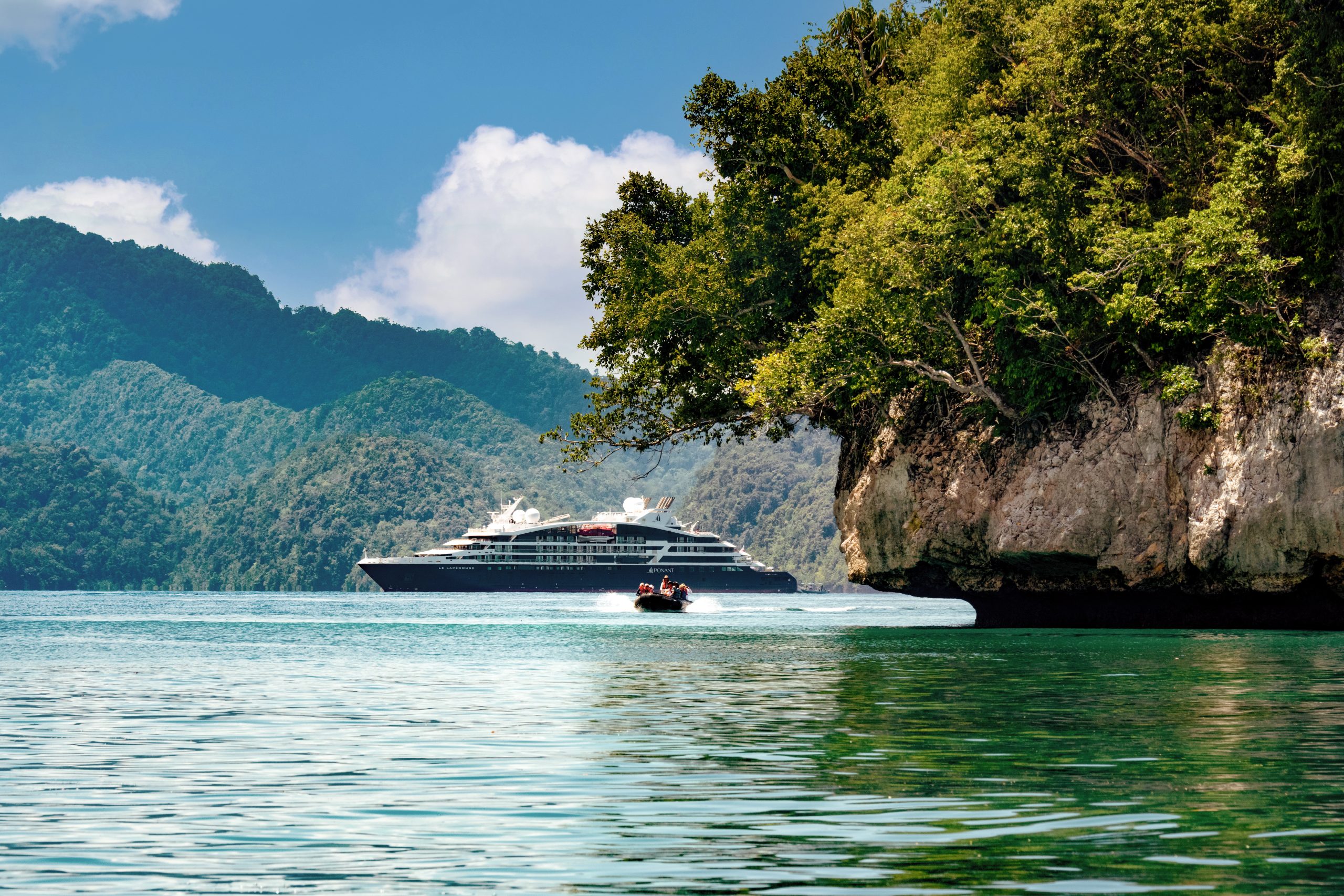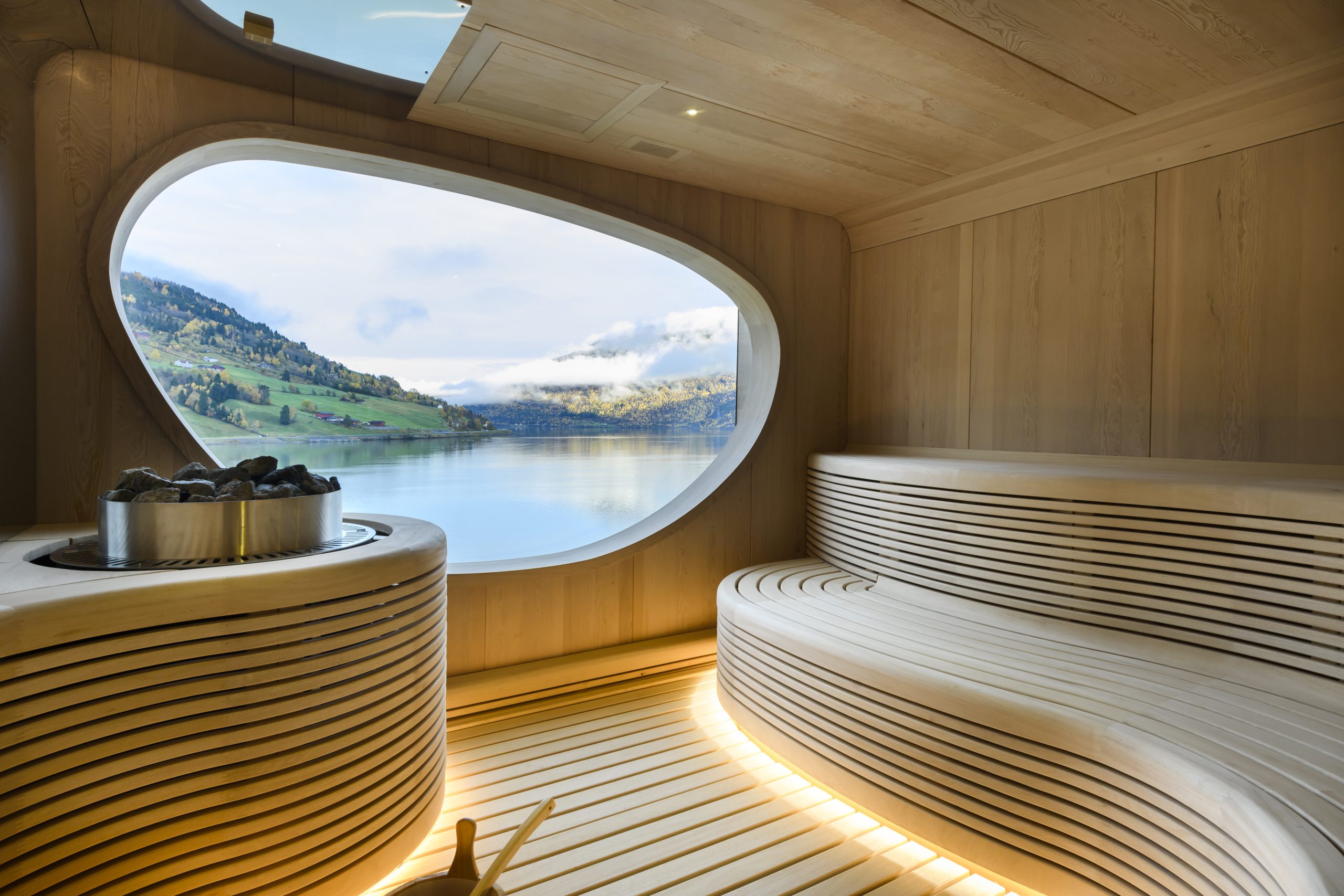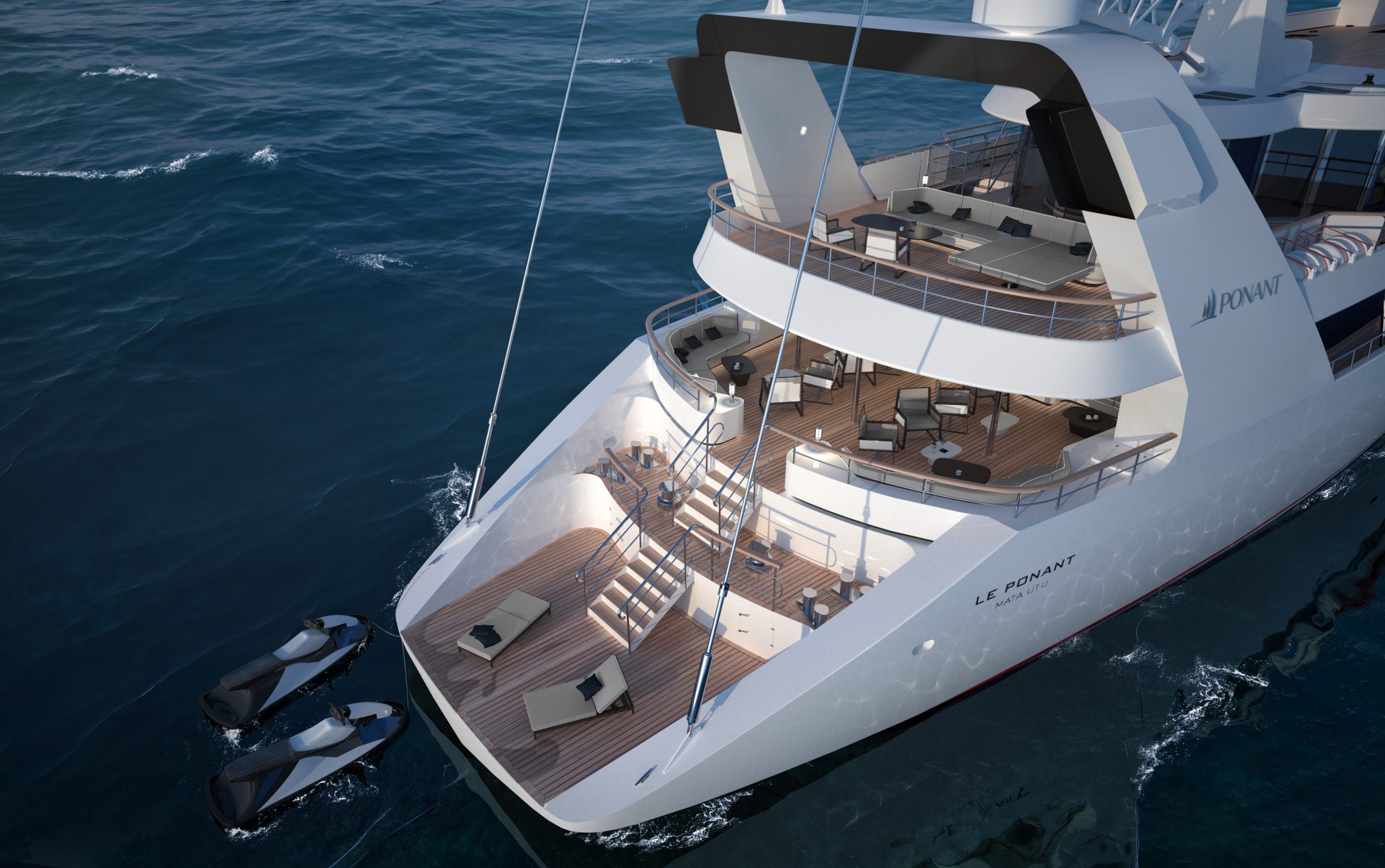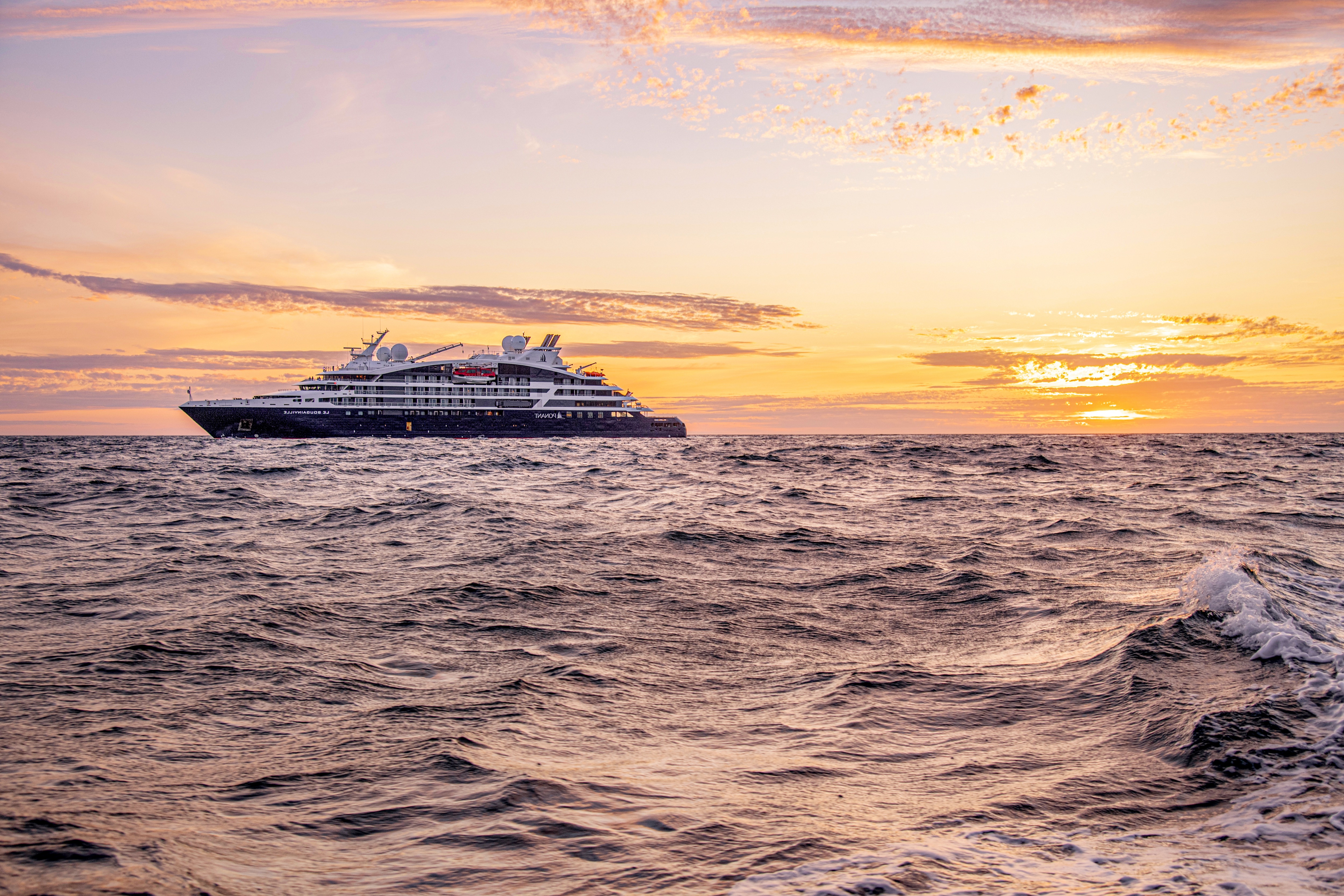Itinerary
United with France only since 1860, Nice has its own history and atmosphere, which dates back 230,000 years. It was on Colline du Château (now château-less) and at the Plage des Ponchettes, in front of the Old Town, that the Greeks established a market-port in 350 BC and named it Nikaia, which would become Marseilles’ chief coastal rival. The Romans established themselves a little later on the hills of Cimiez (Cemenelum), already previously occupied by Ligurians and Celts, and quickly overshadowed the waterfront port. After falling to the Saracen invasions, Nice regained power as an independent state, becoming an important port in the early Middle Ages.So cocksure did it become that in 1388, Nice, along with the hill towns behind, effectively seceded from the county of Provence, under Louis d’Anjou, and allied itself with Savoie. Thus began its liaison with the House of Savoy, and through it with Piedmont and Sardinia, it was the Comté de Nice (Nice County). This relationship lasted some 500 years, tinting the culture, architecture, and dialect in rich Italian hues.By the 19th century Nice was flourishing commercially, locked in rivalry with the neighboring shipping port of Genoa. Another source of income: the dawning of tourism, as first the English, then the Russian nobility, discovered its extraordinary climate and superb waterfront position. A parade of fine stone mansions and hotels closed into a nearly solid wall of masonry, separated from the smooth-round rocks of the beach by what was originally named Camin deis Anglés (the English Way), which of course is now the famous Promenade des Anglais. This magnificent crescent, which is seeking UNESCO recognition, is one of the noblest in France. Many of Nice’s most delightful attractions—the Cours Saleya market, the Old Town streets, the Hotel Negresco, and the Palais Masséna—are on or close to this 10-km (6-mile) waterfront, making it the first stop for most visitors, while the redevelopment of Nice’s port, around the other side of the Colline du Château, makes it easier for amblers who want to take in the Genoese architecture or peruse the antiques at the Puces de Nice, now part of the Promenade des 100 Antiquaires, along Quai Papacino. Nice also has the distinction of the “Family Plus” label, with free strollers, play areas, and restaurants with child-friendly activities.
One of the most photographed villages along the coast, with a decidedly romantic and affluent aura, Portofino has long been a popular destination for the rich and famous. Once an ancient Roman colony and taken by the Republic of Genoa in 1229, it’s also been ruled by the French, English, Spanish, and Austrians, as well as by marauding bands of 16th-century pirates. Elite British tourists first flocked to the lush harbor in the mid-1800s. Some of Europe’s wealthiest drop anchor in Portofino in summer, but they stay out of sight by day, appearing in the evening after buses and boats have carried off the day-trippers.There’s not actually much to do in Portofino other than stroll around the wee harbor, see the castle, walk to Punta del Capo, browse at the pricey boutiques, and sip a coffee while people-watching. However, weaving through picture-perfect cliffside gardens and gazing at yachts framed by the sapphire Ligurian Sea and the cliffs of Santa Margherita can make for quite a relaxing afternoon. There are also several tame, photo-friendly hikes into the hills to nearby villages.Unless you’re traveling on a deluxe budget, you may want to stay in Camogli or Santa Margherita Ligure rather than at one of Portofino’s few very expensive hotels. Restaurants and cafés are good but also pricey (don’t expect to have a beer here for much under €10).
Livorno is a gritty city with a long and interesting history. In the early Middle Ages it alternately belonged to Pisa and Genoa. In 1421 Florence, seeking access to the sea, bought it. Cosimo I (1519–74) started construction of the harbor in 1571, putting Livorno on the map. After Ferdinando I de’ Medici (1549–1609) proclaimed Livorno a free city, it became a haven for people suffering from religious persecution; Roman Catholics from England and Jews and Moors from Spain and Portugal, among others, settled here. The Quattro Mori (Four Moors), also known as the Monument to Ferdinando I, commemorates this. (The statue of Ferdinando I dates from 1595, the bronze Moors by Pietro Tacca from the 1620s.)In the following centuries, and particularly in the 18th, Livorno boomed as a port. In the 19th century the town drew a host of famous Britons passing through on their grand tours. Its prominence continued up to World War II, when it was heavily bombed. Much of the town’s architecture, therefore, postdates the war, and it’s somewhat difficult to imagine what it might have looked like before. Livorno has recovered from the war, however, as it’s become a huge point of departure for container ships, as well as the only spot in Tuscany for cruise ships to dock for the day.Most of Livorno’s artistic treasures date from the 17th century and aren’t all that interesting unless you dote on obscure baroque artists. Livorno’s most famous native artist, Amedeo Modigliani (1884–1920), was of much more recent vintage. Sadly, there’s no notable work by him in his hometown.There may not be much in the way of art, but it’s still worth strolling around the city. The Mercato Nuovo, which has been around since 1894, sells all sorts of fruits, vegetables, grains, meat, and fish. Outdoor markets nearby are also chock-full of local color. The presence of Camp Darby, an American military base just outside town, accounts for the availability of many American products.If you have time, Livorno is worth a stop for lunch or dinner at the very least.
At first glance, it’s hard to imagine that this resort destination was one of the world’s great naval powers, and a sturdy rival of Genoa and Pisa for control of the Mediterranean in the 11th and 12th centuries. Once the seat of the Amalfi Maritime Republic, the town is set in a verdant valley of the Lattari Mountains, with cream-colored and pastel-hued buildings tightly packing a gorge on the Bay of Salerno. The harbor, which once launched the greatest fleet in Italy, now bobs with ferries and blue-and-white fishing boats. The main street, lined with shops and pasticcerie, has replaced a raging mountain torrent, and terraced hills flaunt the green and gold of lemon groves. Bearing testimony to its great trade with Tunis, Tripoli, and Algiers, Amalfi remains honeycombed with Arab-Sicilian cloisters and covered passages. In a way Amalfi has become great again, showing off its medieval glory days with sea pageants, convents-turned-hotels, ancient paper mills, covered streets, and its glimmering cathedral.
The medieval cliff-hanging town of Taormina is overrun with tourists, yet its natural beauty is still hard to dispute. The view of the sea and Mt. Etna from its jagged cactus-covered cliffs is as close to perfection as a panorama can get—especially on clear days, when the snowcapped volcano’s white puffs of smoke rise against the blue sky. Writers have extolled Taormina’s beauty almost since it was founded in the 6th century BC by Greeks from nearby Naxos; Goethe and D. H. Lawrence were among its well-known enthusiasts. The town’s boutique-lined main streets get old pretty quickly, but the many hiking paths that wind through the beautiful hills surrounding Taormina promise a timeless alternative. A trip up to stunning Castelmola (whether on foot or by car) should also be on your itinerary.
Located right in the heel of the Italian boot, Otranto’s scenic landscape often plays the protagonist in displaying the beauty of Puglia, Italy’s easternmost region. Facing the Adriatic sea, the seducing weather and pristine waters have made it a popular destination where on a clear day, wanderers can see the coast of Albania. Like much of Italy, the city boasts a rich and mixed history. Once a Greek and Roman port, it was later occupied by the Byzantines, the Normans and the Spanish before the Ottoman invaded in during their Jihad to conquer Europe. Remains of forts are still visible and are a living testimonial of the town’s rich history along with Otranto’s cathedral, which still encloses today the relics of martyrs who refused to convert to Islam.
Ancona is the capital of Italy’s Marche region. Ancona’s main attraction is her tactile museum for the blinds. It’s also a great place to take a dip and enjoy great sea views under the sunshine.
A small, quiet, well-heeled city, Ravenna has brick palaces, cobblestone streets, magnificent monuments, and spectacular Byzantine mosaics. The high point in its civic history occurred in the 5th century, when Pope Honorious moved his court here from Rome. Gothic kings Odoacer and Theodoric ruled the city until it was conquered by the Byzantines in AD 540. Ravenna later fell under the sway of Venice, and then, inevitably, the Papal States.Because Ravenna spent much of its past looking east, its greatest art treasures show that Byzantine influence. Churches and tombs with the most unassuming exteriors contain within them walls covered with sumptuous mosaics. These beautifully preserved Byzantine mosaics put great emphasis on nature, which you can see in the delicate rendering of sky, earth, and animals. Outside Ravenna, the town of Classe hides even more mosaic gems.
Venice is a city unlike any other. No matter how often you’ve seen it in photos and films, the real thing is more dreamlike than you could imagine. With canals where streets should be, water shimmers everywhere. The fabulous palaces and churches reflect centuries of history in what was a wealthy trading center between Europe and the Orient. Getting lost in the narrow alleyways is a quintessential part of exploring Venice, but at some point you’ll almost surely end up in Piazza San Marco, where tourists and locals congregate for a coffee or an aperitif.
Ship features
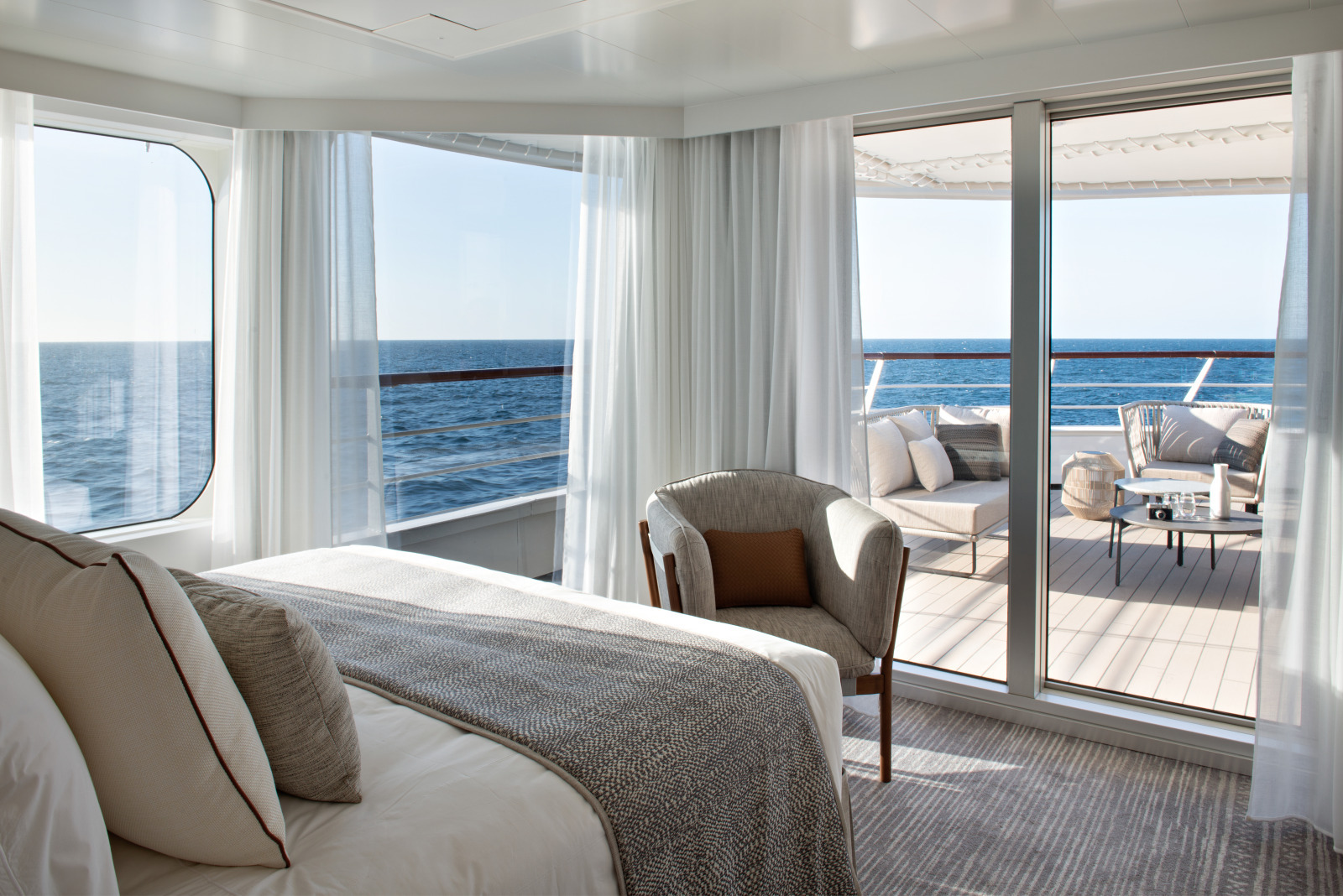
Owner's Suite
Services provided
- 24-hour room service
- Inclusive Wifi internet access (availability dependent on navigation and latitude)
- Individually-controlled air conditioning
- Dressing room with shelves and closet
- Dressing table and hairdryer
- Diptyque Paris top-of-the-line bath products
- Minibar
- Nespresso coffee maker and boiler
- Electronic safe
- Direct line telephone
- Bose Bluetooth speaker
- Flat screen TV, international channels (availability dependent on navigation) and videos on demand
- 110V American (two flat pins)/220V European (round sockets with two round pins)
- Two ADA staterooms
In addition to the common services provided to all our suites and staterooms:
- Private return transfer
- Priority boarding
- Champagne and fruit basket on arrival
- Butler service
- An assortment of sweet or savoury canapés and fruit basket every day
- A lounge with armchair, double sofa bed (160 x 190 cm), and second TV
- A bedroom with king-size bed (180 x 200 cm) or two single beds (90 x 200 cm)
- A bathroom with shower, Balneo bathtub and smart mirror
- A one-hour spa treatments per person (for 2 people) in the well-being space, chosen from the facial and body treatments on offer
- Included premium pass: access to a selection of premium spirits at the bar
- A private 40 m² terrace: 2 deckchairs, jacuzzi, and outdoor lounge area with sofa and armchair
- Two panoramic sliding bay windows
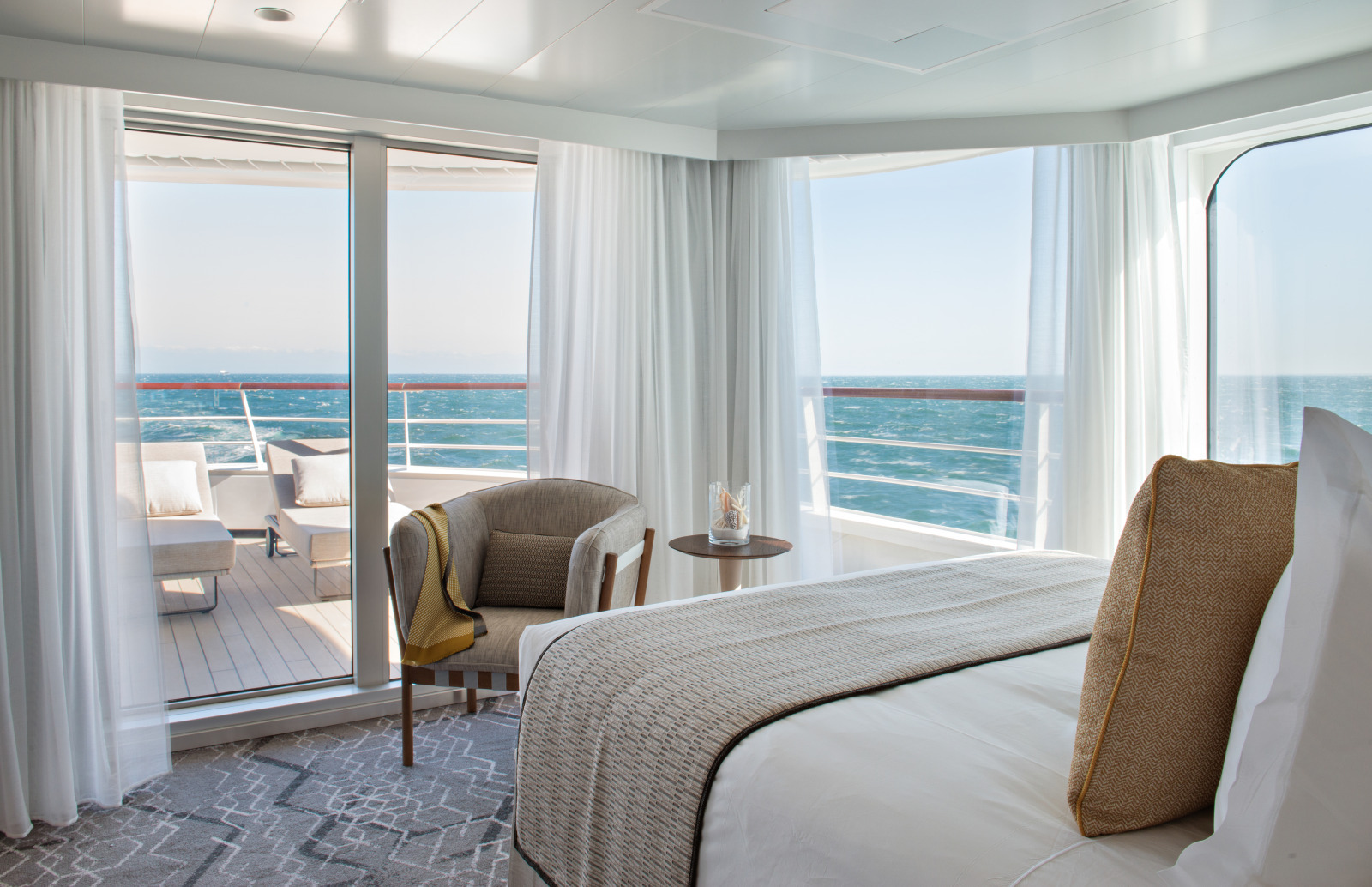
Grand Deluxe Suite
Services provided
- 24-hour room service
- Inclusive Wifi internet access (availability dependent on navigation and latitude)
- Individually-controlled air conditioning
- Dressing room with shelves and closet
- Dressing table and hairdryer
- Diptyque Paris top-of-the-line bath products
- Minibar
- Nespresso coffee maker and boiler
- Electronic safe
- Direct line telephone
- Bose Bluetooth speaker
- Flat screen TV, international channels (availability dependent on navigation) and videos on demand
- 110V American (two flat pins)/220V European (round sockets with two round pins)
- Two ADA staterooms
In addition to the common services provided to all our suites and staterooms:
- Priority boarding
- Champagne and fruit basket on arrival
- Butler service
- An assortment of sweet or savoury canapés and fruit basket every day
- A bedroom with one king-size bed (180 x 200 cm) or two single beds (90 x 200 cm)
- A lounge with sofa convetible to a double bed (160 x 190 cm), armchair, and second TV
- A bathroom with shower and Balneo bathtub
- A private 32 m² terrace with two deckchairs and four-seater dining table
- 2 panoramic sliding bay windows
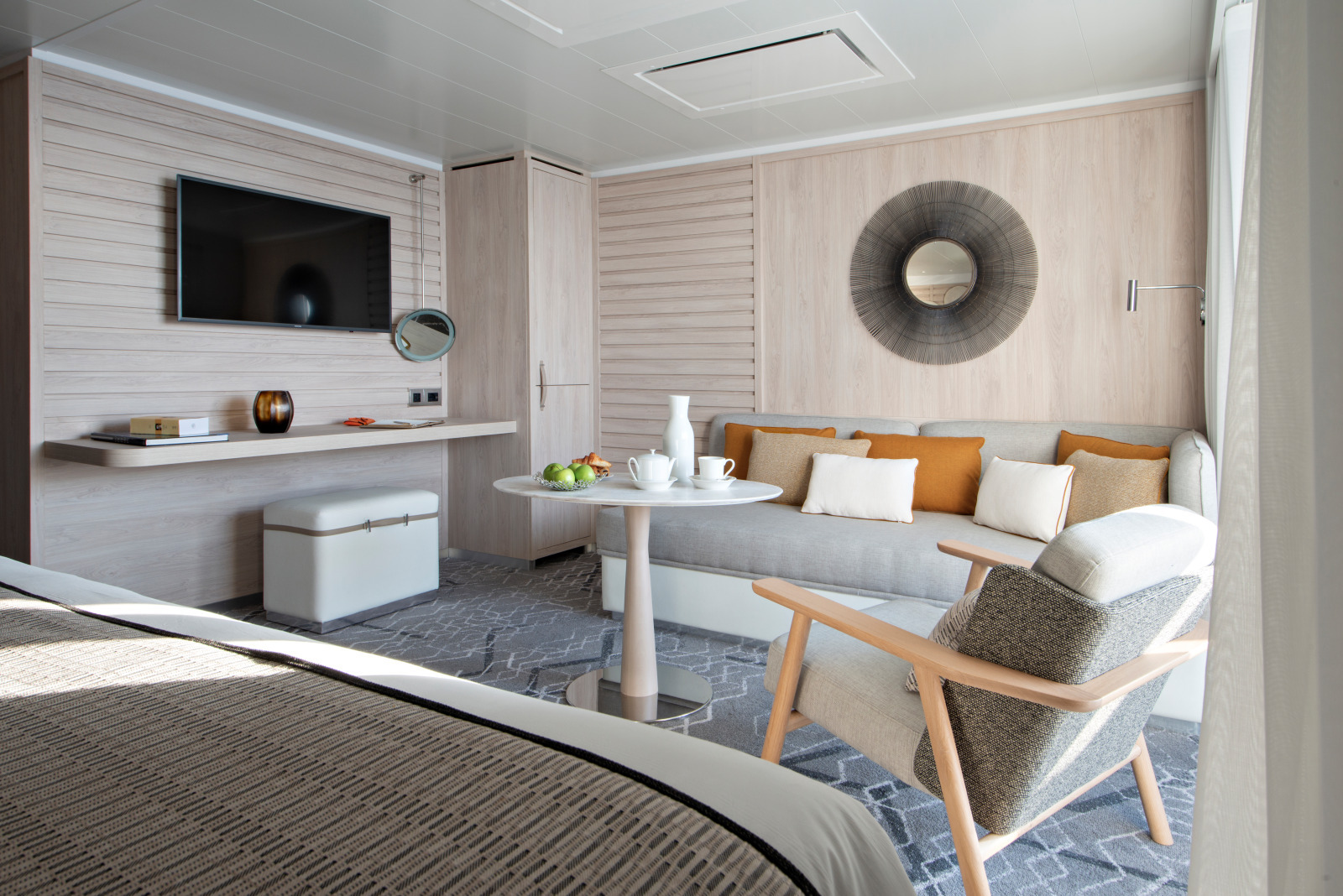
Privilege Suite
Services provided
- 24-hour room service
- Inclusive Wifi internet access (availability dependent on navigation and latitude)
- Individually-controlled air conditioning
- Dressing room with shelves and closet
- Dressing table and hairdryer
- Diptyque Paris top-of-the-line bath products
- Minibar
- Nespresso coffee maker and boiler
- Electronic safe
- Direct line telephone
- Bose Bluetooth speaker
- Flat screen TV, international channels (availability dependent on navigation) and videos on demand
- 110V American (two flat pins)/220V European (round sockets with two round pins)
- Two ADA staterooms
In addition to the common services provided to all our suites and staterooms:
- Priority boarding
- Champagne and fruit basket on arrival
- Butler service
- An assortment of sweet or savoury canapés and fruit basket every day
- One king-size bed (180 x 200 cm) or two single beds (90 x 200 cm)
- A lounge area with chaise longue and armchair
- A bathroom with shower
- A private 8 m² balcony with two armchairs
- A panoramic sliding bay window

Prestige Suite
Services provided
- 24-hour room service
- Inclusive Wifi internet access (availability dependent on navigation and latitude)
- Individually-controlled air conditioning
- Dressing room with shelves and closet
- Dressing table and hairdryer
- Diptyque Paris top-of-the-line bath products
- Minibar
- Nespresso coffee maker and boiler
- Electronic safe
- Direct line telephone
- Bose Bluetooth speaker
- Flat screen TV, international channels (availability dependent on navigation) and videos on demand
- 110V American (two flat pins)/220V European (round sockets with two round pins)
- Two ADA staterooms
In addition to the common services provided to all our suites and staterooms:
- Priority boarding
- Champagne and fruit basket on arrival
- Butler service
- An assortment of sweet or savoury canapés and fruit basket every day
- A bedroom with king-size bed (180 x 200 cm) or two single beds (90 x 200 cm)
- A lounge with convertible sofa to a king-size bed (180 x 200 cm) or two single beds (90 x 200 cm), armchair, second TV, and sliding courtesy door
- Two bathrooms with shower
- A private 8 m² balcony with four armchairs
- Two panoramic sliding bay windows

Deluxe Suite
Services provided
- 24-hour room service
- Inclusive Wifi internet access (availability dependent on navigation and latitude)
- Individually-controlled air conditioning
- Dressing room with shelves and closet
- Dressing table and hairdryer
- Diptyque Paris top-of-the-line bath products
- Minibar
- Nespresso coffee maker and boiler
- Electronic safe
- Direct line telephone
- Bose Bluetooth speaker
- Flat screen TV, international channels (availability dependent on navigation) and videos on demand
- 110V American (two flat pins)/220V European (round sockets with two round pins)
- Two ADA staterooms
- In addition to the common services provided to all our suites and staterooms:
- Champagne and fruit basket on arrival
- One king-size bed (180 x 200 cm) or two single beds (90 x 200 cm)
- An armchair and sofa (90 x 190 cm)
- A bathroom with shower
- A private 6 m² balcony with two armchairs
- A panoramic sliding bay window

Deluxe Stateroom
- Services provided
- 24-hour room service
- Inclusive Wifi internet access (availability dependent on navigation and latitude)
- Individually-controlled air conditioning
- Dressing room with shelves and closet
- Dressing table and hairdryer
- Diptyque Paris top-of-the-line bath products
- Minibar
- Nespresso coffee maker and boiler
- Electronic safe
- Direct line telephone
- Bose Bluetooth speaker
- Flat screen TV, international channels (availability dependent on navigation) and videos on demand
- 110V American (two flat pins)/220V European (round sockets with two round pins)
- Two ADA staterooms
In addition to the common services provided to all our suites and staterooms:
- One king-size bed (180 x 200 cm) or two single beds (90 x 200 cm) and TV
- A bathroom with shower
- A private 4 m² balcony with two armchairs
- A glazed panoramic swing door and rectangular window
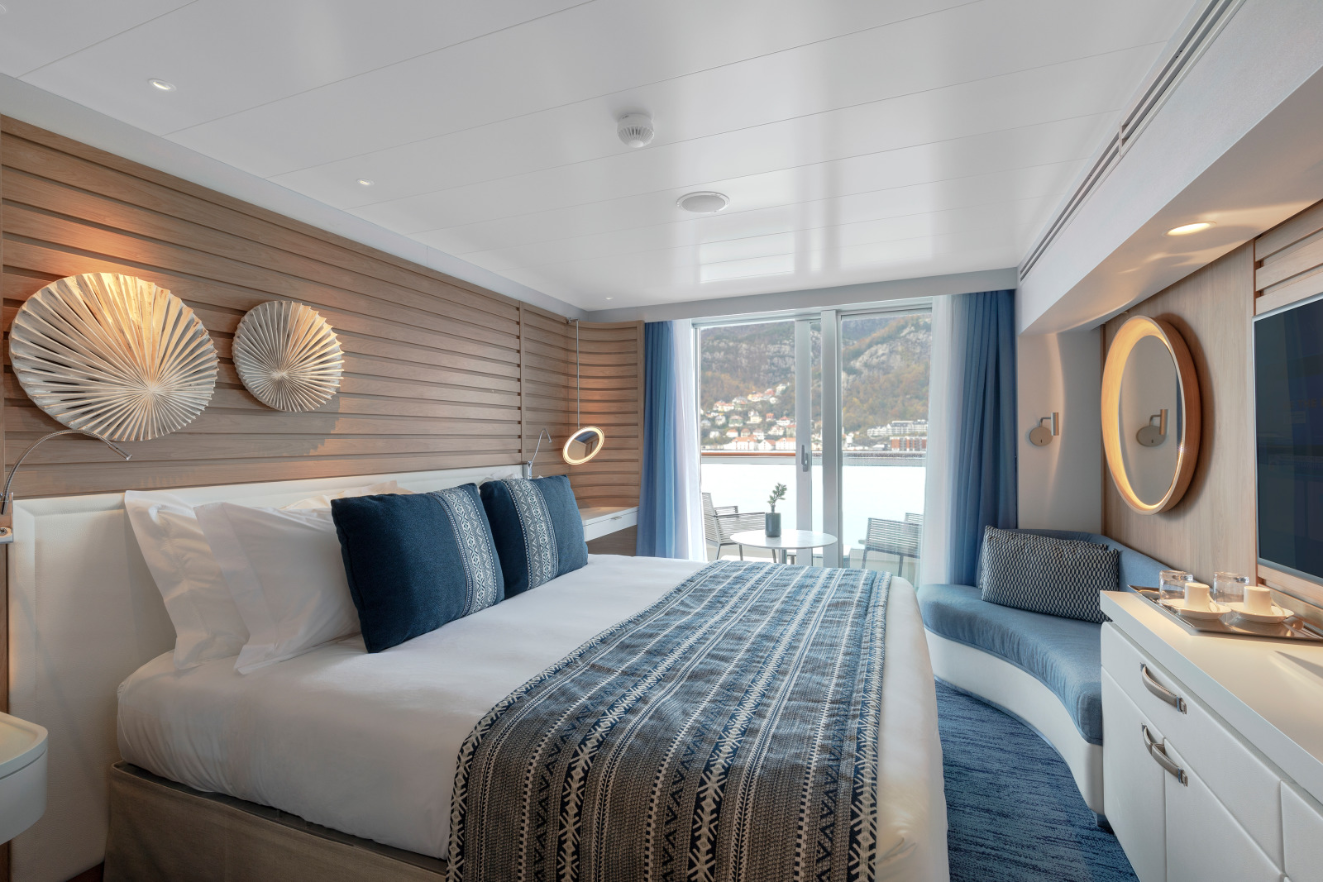
Prestige Stateroom
Services provided
- 24-hour room service
- Inclusive Wifi internet access (availability dependent on navigation and latitude)
- Individually-controlled air conditioning
- Dressing room with shelves and closet
- Dressing table and hairdryer
- Diptyque Paris top-of-the-line bath products
- Minibar
- Nespresso coffee maker and boiler
- Electronic safe
- Direct line telephone
- Bose Bluetooth speaker
- Flat screen TV, international channels (availability dependent on navigation) and videos on demand
- 110V American (two flat pins)/220V European (round sockets with two round pins)
- Two ADA staterooms
In addition to the common services provided to all our suites and staterooms:
- One king-size bed (180 x 200 cm) or two single beds (90 x 200 cm)
- One chaise longue
- A bathroom with shower
- A private 4 m² balcony with two armchairs
- A panoramic sliding bay window or glazed panoramic swing door
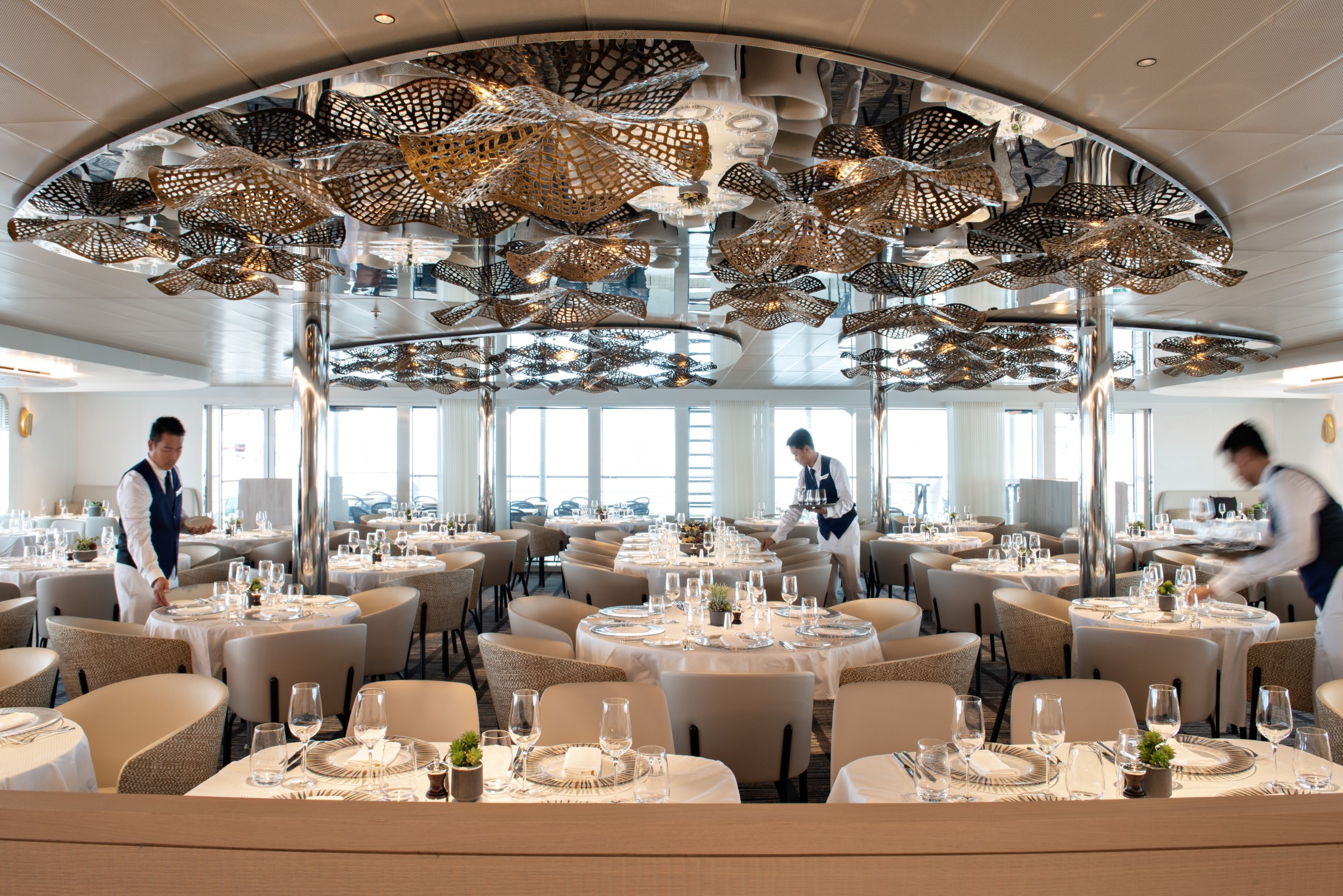
Le Nautilus
Towards the rear of deck 4 you’ll find a panoramic restaurant large enough to accommodate all our passengers at one sitting. Offering a different concept than on our other ships, this space is open to the exterior and serves buffets of salads, desserts and cheeses. Our discreet and attentive staff provide a table service for hot meals.
- 260 m2 (2,800 ft²)
- Wine cellar
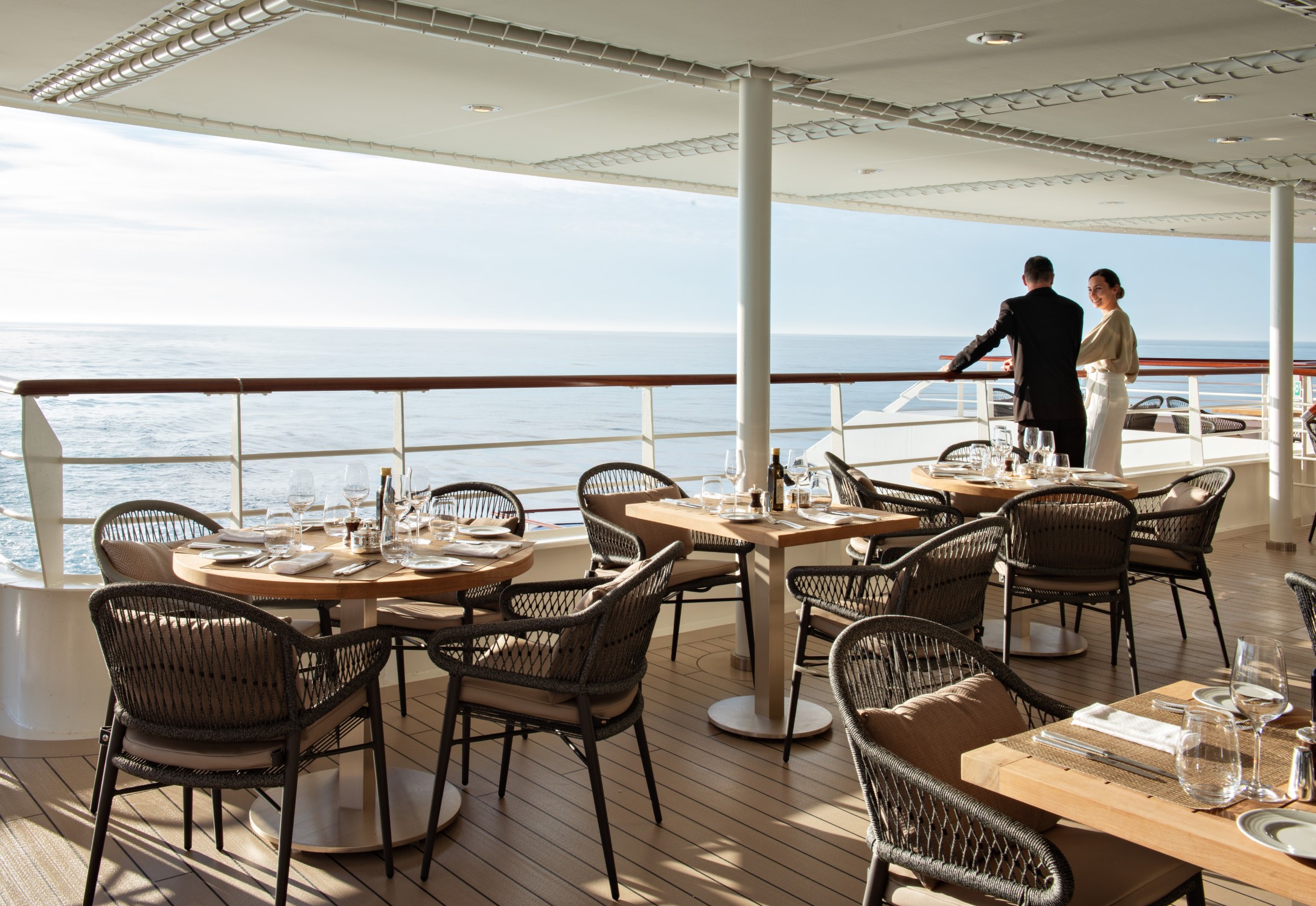
Grill Restaurant
An exterior grill restaurant on deck 3 offering a relaxed ambiance and atmosphere:
- Capacity: 70
- Views out over the pool deck
- Grilled meats and a variety of salads and desserts
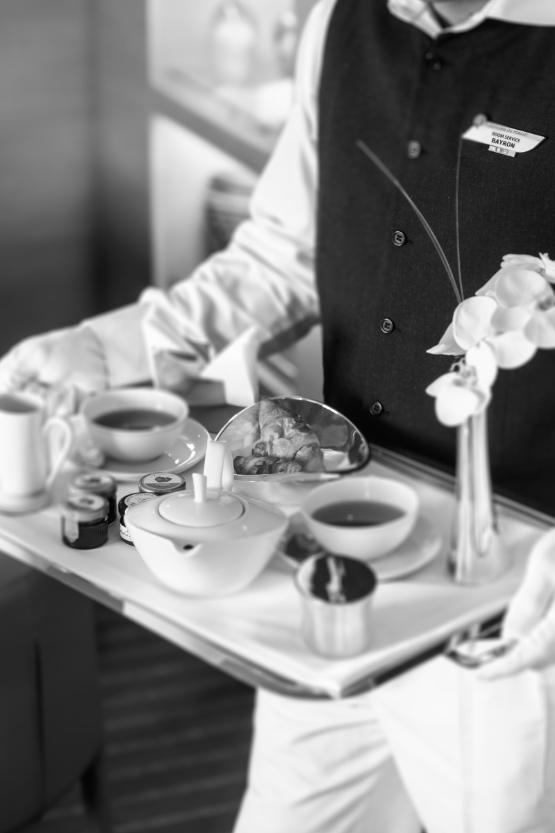
Room Service
Whether you wish to have breakfast in the privacy of your cabin, savour a snack in the middle of the day or enjoy your dinner in an intimate setting, our Room Service is available for you. Have a gourmet interlude and treat yourself from a varied menu at any time of day or night *.
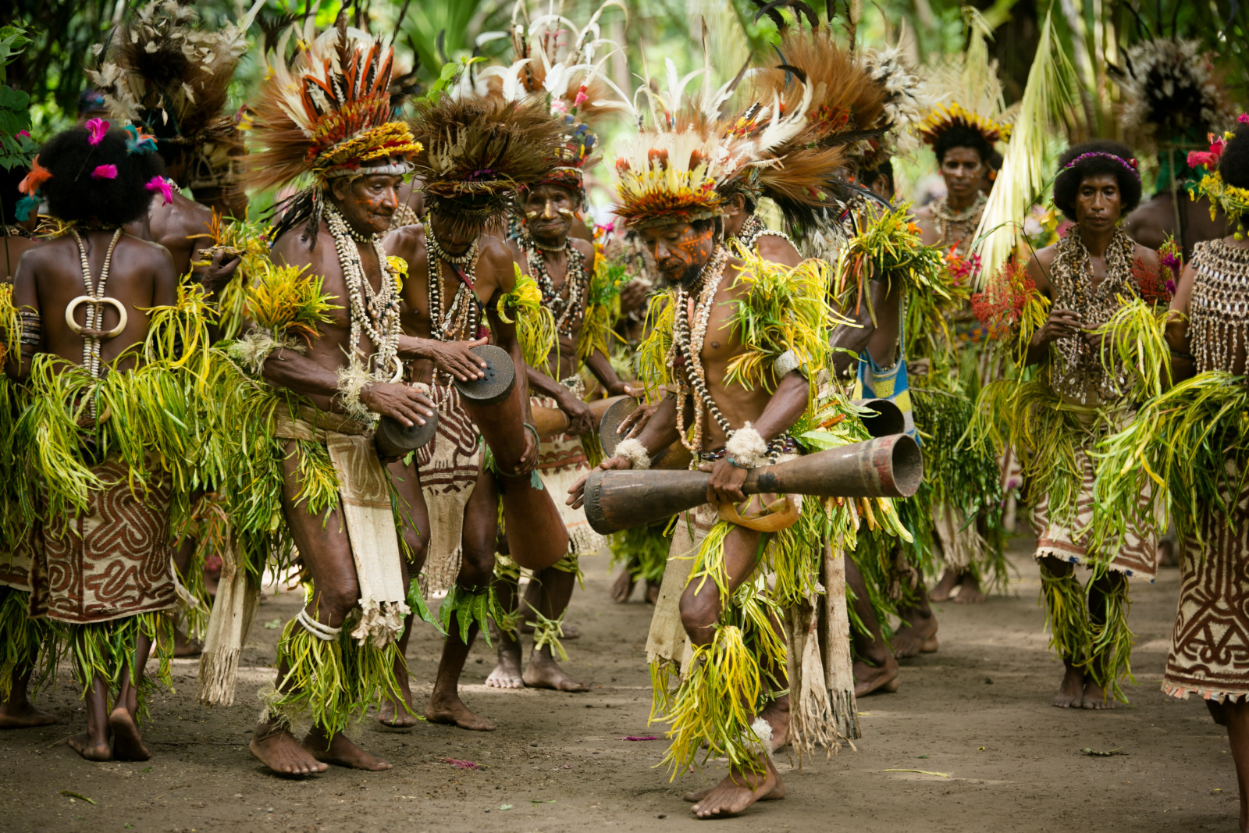
Excursions
Excursions & land itineraries
Each itinerary has been thoughtfully created by our teams to offer you a complete excursion experience. You can discover the hidden gems of the regions you visit in line with your interests.
Hidden creeks, ancient cities, UNESCO world heritage sites… the world reveals its hidden gems as you journey along the routes taken by travellers. In keeping with our ethos “Accessing the worlds treasures by sea”, we offer a wide choice of land excursions during all our cruises (except for expeditions). Chosen by our PONANT experts for their cultural value and historic interest, these excursions can last a few hours or a few days. If you need to stay on land overnight, we take care of your stay from start to finish, until you rejoin your ship. These longer excursions mean you can discover the unmissable sites of the region you are visiting, like Cuzco in Peru for example or the Mekong Delta in Vietnam.
You can access these trips by pre-booking two months before your departure date.
A varied choice of leisure activities
We offer a range of excursions based on a variety of themes. You can choose your land activities according to your preferences and desires, whether they’re cultural or sporting.
Choose your excursion from a selection of unmissable sites, UNESCO sites, Cultural or Heritage visits, Nature and Adventure, Culinary Discovery and even our Originals.
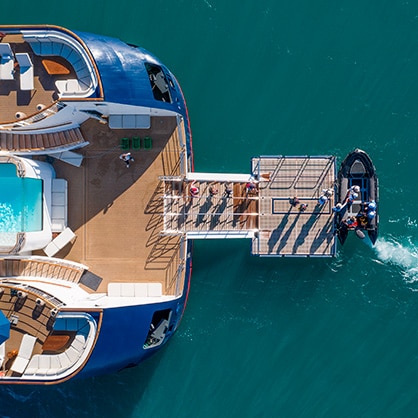
The Hydraulic Platform
- Deck 2
- Much easier onboard access than on any other cruise ship
- Easier disembarking and embarking by Zodiac when participating in expeditions
- Swimming and bathing in the sea and various nautical sports, such as kayaking and paddle-boarding
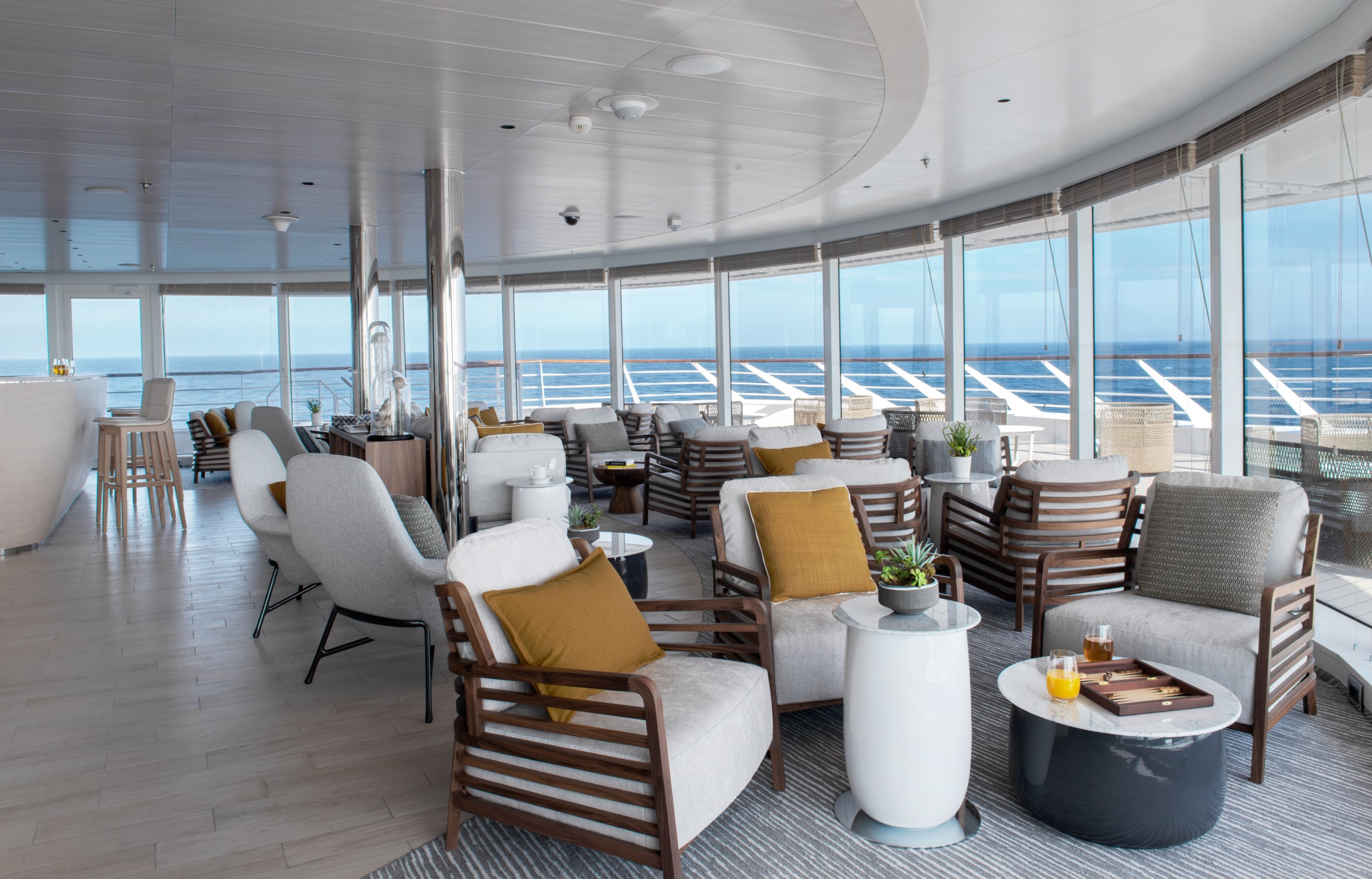
Panoramic Lounge
- Deck 6
- Library, internet space, bar, and live entertainment on certain evenings
- Direct access to the panoramic terrace
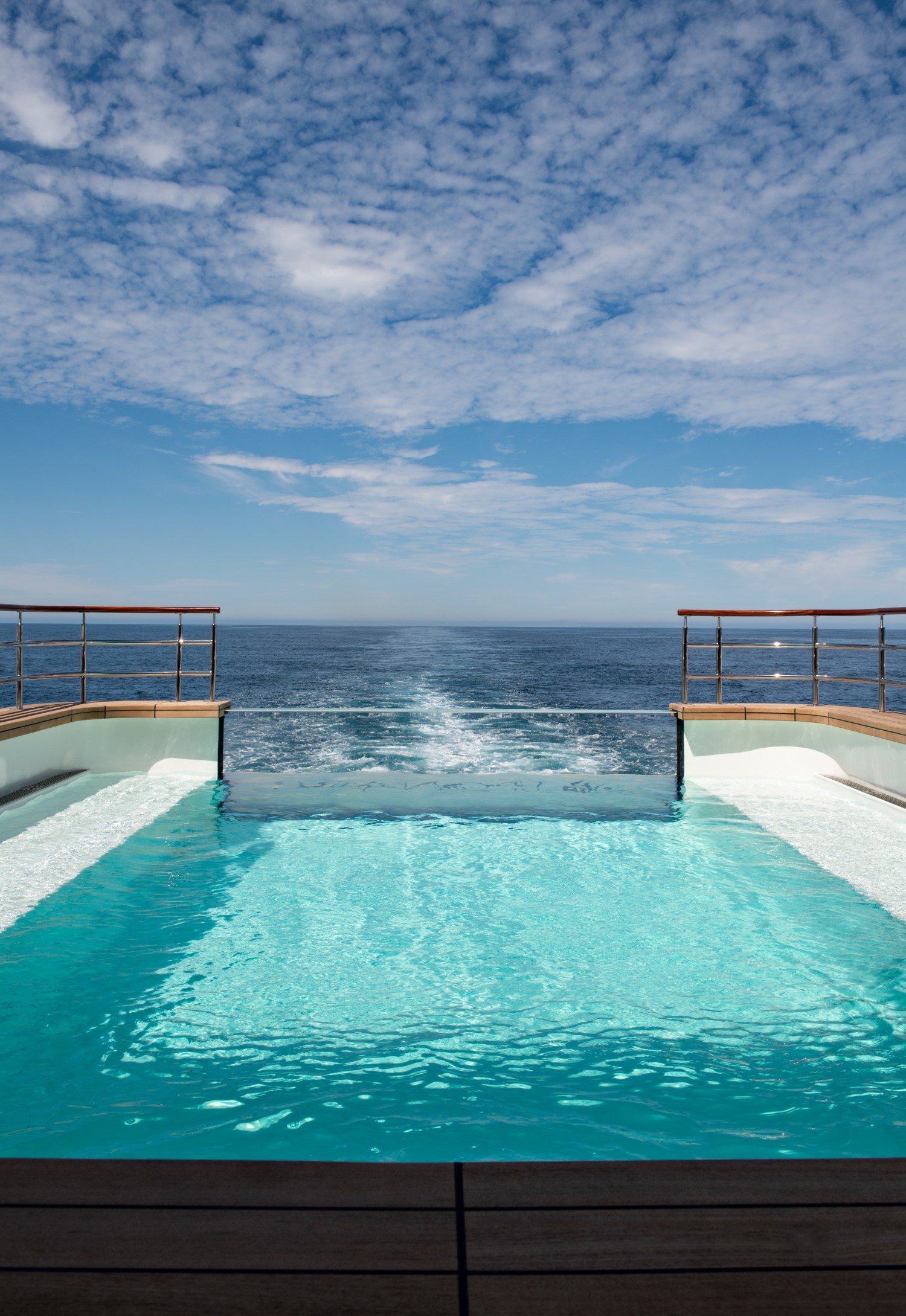
Pool & Sun Deck
The outdoor areas on our ships, comfortable and conducive to relaxation, have been designed to merge into the sublime scenery and surroundings of the sea and horizon. There is a heated seawater pool featuring its own sun lounge on the top deck of our sister ships (Le Boréal, L’Austral, Le Soléal and Le Lyrial) and on the third deck of the PONANT EXPLORERS (Le Lapérouse, Le Champlain, Le Bougainville, Le Dumont-D’Urville, Le Jacques Cartier and Le Bellot). Le Ponant is equipped with a 400 m² (4,300 ft²) sun deck.
The pool deck – Deck 3
- A swimming pool offering panoramic views and equipped with a counter-current system
- A pleasant, attractive sun deck
- An exterior bar and lounge equipped with armchairs and sofas

Lounges & Bars
Different lounges enable guests to socialise and share convivial moments during their cruise. Discover the following on our four sisterships: the main lounge, an ideal place to meet over a drink and watch daytime or evening events; the panoramic lounge, an intimate piano-bar with a unique view of the horizon; and the outdoor bar, an atmospheric spot that has access to the pool and solarium.
The various different lounges allow passengers to meet up and share quality time together.
- The main lounge is the ideal place to relax with a drink and enjoy the various activities that have been organised such as dancing classes or theme evenings.
- The cosy piano bar is a panorama lounge with breathtaking views of the horizon.
- The outside bar is a great space for relaxing and is handy for accessing the swimming pool* and its solarium.
The Main Lounge – Deck 3
- A 200 m² (2,150 ft²) main lounge
- Able to accommodate all our passengers at once for moments of shared conviviality, and as a venue for both daytime and evening shows and entertainment
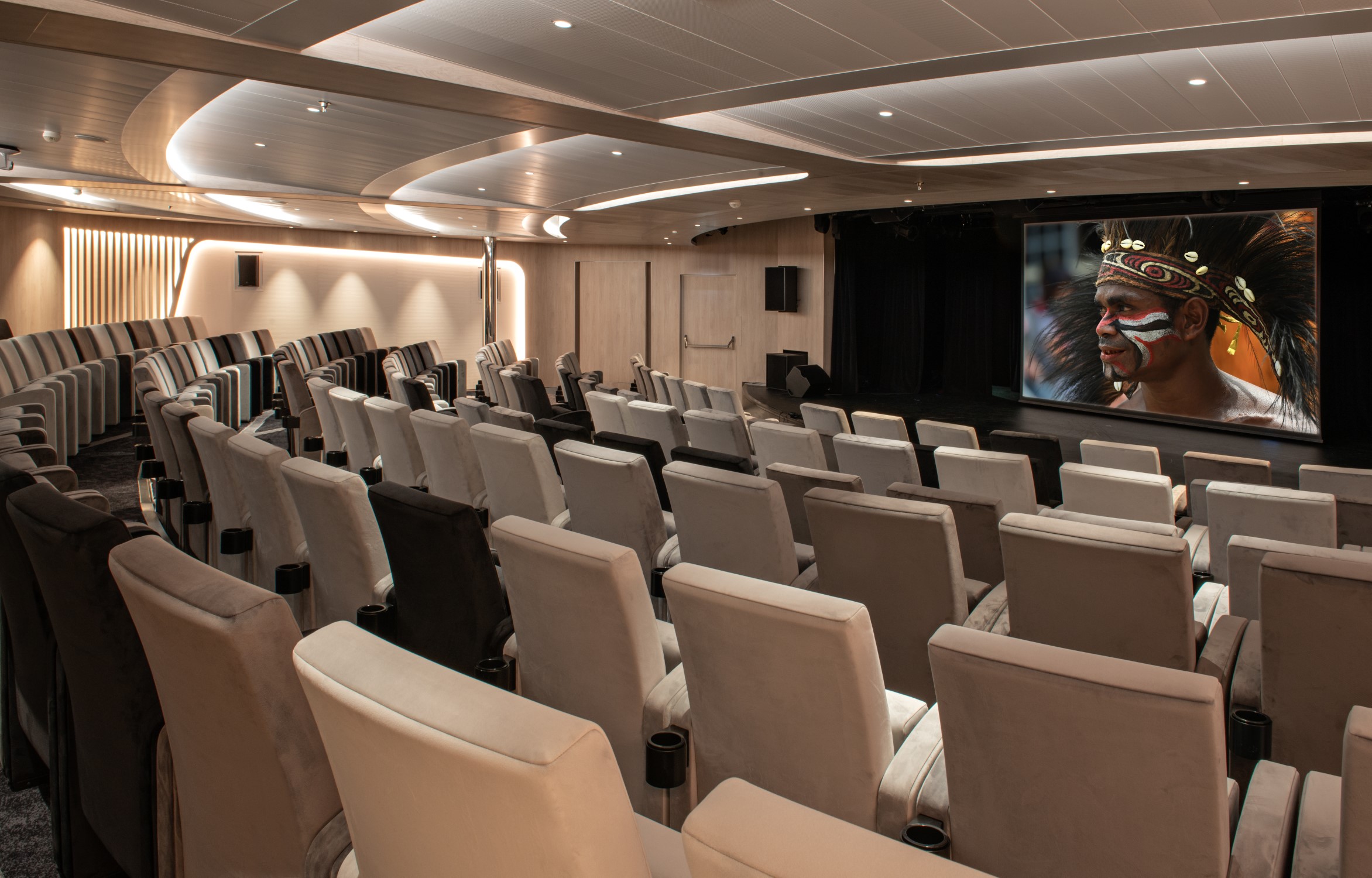
Theatre
The Theatre* is the most unique meeting space on board. It’s the largest space on the ship and regularly accommodates all the passengers. It plays host to shows and entertainment as well as conferences from our experts, naturalist guides and guests of honours. The Theatre makes every cruise unique and enriching thanks to its constant and very accessible events.
There are performers on board all of our ships. Recruited for their talent in Paris and Rome, they star in multiple shows at the Theatre, after dinner. Throughout your voyage, they host the various entertainment events in the Grand Salon, with the support of our on-board musicians
During Tea Time or before dinner, our musical duos consisting of a singer and an accompanying musician play classical repertoires for you. In the evening, they play in concert at the Theatere or invite you to show off your dance moves. Dance evenings are thus co-led by performance dancers who know just how to keep you in step, under the direction of the Cruise Director.
There’s plenty of themed entertainment to enjoy in the evenings. Both a soirée blanche (dress-in-white party) and an officers’ evening are held on all long cruises. Other types of parties or evening events may also be on the programme, such as karaoke parties, a Casino parties or games evenings.
Films are regularly shown at the Theatre on giant screens. National Geographic features, documentaries related to our expedition route and feature films contribute to the cultural enrichment that is part of our cruise philosophy.
- 188-seat capacity
- Cutting edge audio and lighting technology
- LED stage background wall enabling the projection of ultra-high resolution media

Shop
On board all our ships, a shop is open during sailing. It offers a selection of presents and souvenirs: clothing, jewellery, beauty products, postcards and accessories.
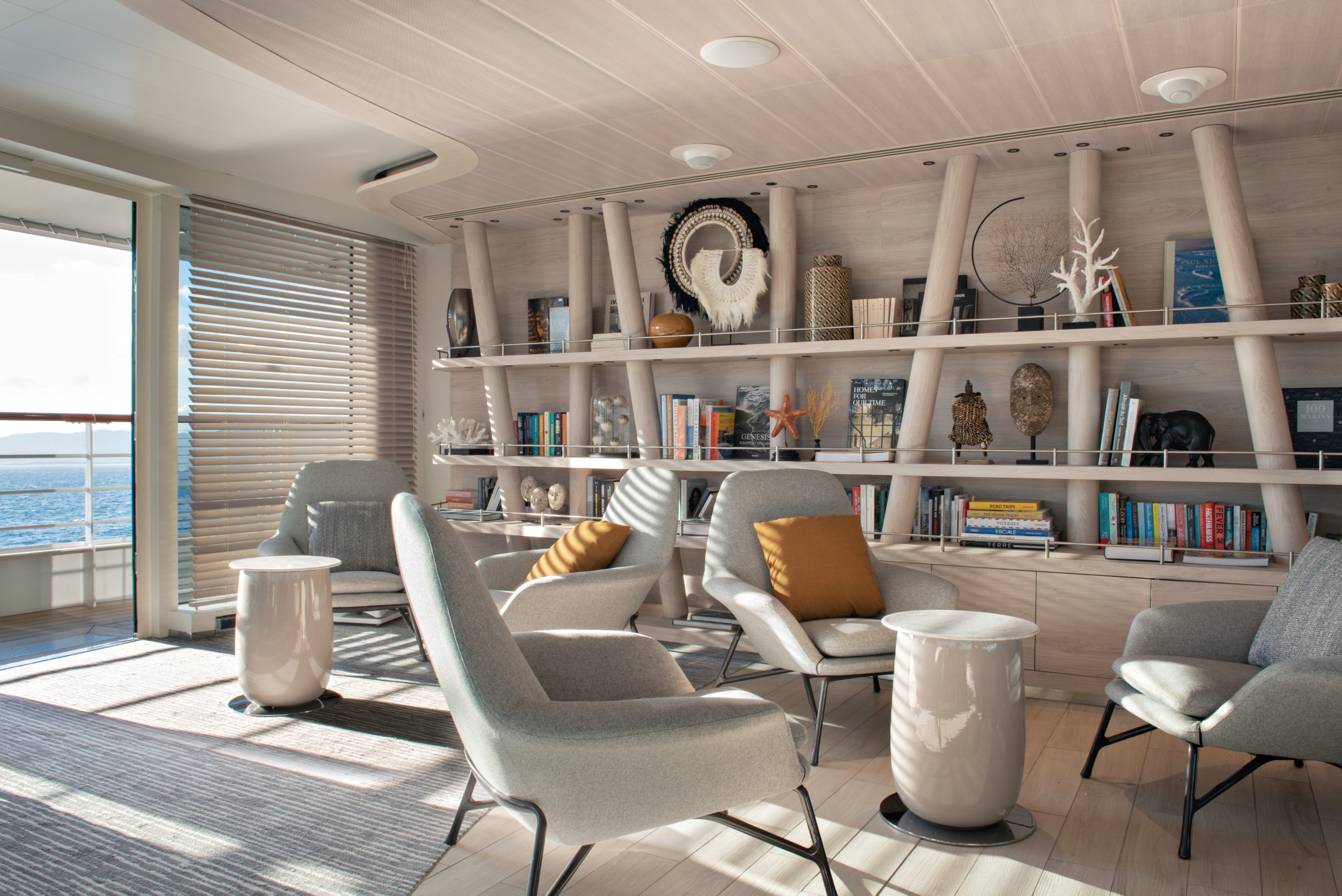
Leisure Areas
Dedicated to leisure and relaxation, the libraries onboard all our ships stock a range of books and board games. This space is also equipped with Wi-Fi connected computers.
All the ships have a special area for children onboard known as the Le Kids Club. Books, television, board games and consoles (PS4 or Wii™) are all provided for their use and enjoyment.

PONANT Studio
A photography and videography team escort you throughout your trip. These professionals capture the most beautiful moments of your cruise, which you can share with family and friends upon your return. Meet them on DECK 5 (DECK 6 on the PONANT Explorers ships) at the photo/video area, where you can also order souvenir pictures and videos.
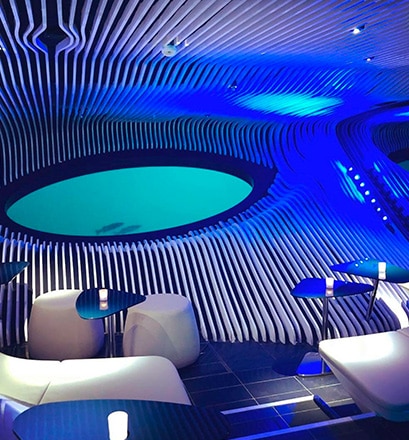
The Blue Eye
Every ship** in the PONANT EXPLORERS series features the Blue Eye. Located in the hull, below the waterline, this unique multi-sensory lounge that is unique to Ponant cruises plunges you into the heart of underwater life. Sight, hearing, and sensations… With digital screens, hydrophones and Body Listening sofas, you can experience the complete and unprecedented spectacle offered by the seabed.
Accessible to all passengers and equipped with a bar, the Blue Eye is an exceptional place to share a drink in a unique atmosphere.
The Blue Eye – Deck 0
- An underwater lounge
- Enough room for 40 passengers

Excursion Reception and Office
On board the sisterships (Le Boreal, L’Austral, Le Soléal and Le Lyrial) and PONANT EXPLORERS, the reception desk and the excursion desk are arranged side by side to facilitate all your requests.
Reception: our receptionists can accommodate you 24 hours a day on all our ships to answer all your needs, such as room service, etc.
The excursion office: the excursion team is available at all times to tell you about the onshore programmes, organise group or private excursions and to manage transfers at the start or end of the cruise.
-
Reception – Deck 3
- A 140 m² (1,500 ft²) space
- A reception/concierge service
- The excursions desk
- The onboard administrative services
- The sales office operated by our Customer Manager
- Our 50m² (540 ft²) shop selling a line of clothing, jewellery, beauty care products, postcards and various accessories.
- The facilities accessible to persons with reduced mobility
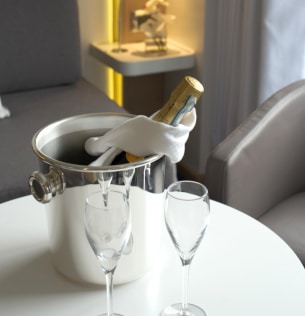
Open Bar
From the moment you board and throughout your cruise, your unlimited drinks are included*, at any time of the day. A drink with friends at the bar, refreshments on your return from an excursion or in the calm of your Stateroom’s balcony: enjoy a large selection of beverages (mineral waters, cold drinks, cruise wines, beer, champagne, spirits, coffee, tea). A selection of premium alcoholic drinks is also available “à la carte”.
*It doesn’t include premium alcoholic drinks indicated in the Bar Menu. It is valid only for individual personal consumption, without limitations.

The Spa
All our ships feature an onboard spa. Equipped with massage cabins, a Turkish bath (Sisterships, Le Paul Gauguin), a sauna (Explorers, Le Commandant Charcot), or a Snow Room (Le Commandant Charcot), the spas offer a wide choice of top-of-the-range treatments provided in association with SOTHYS™, CLARINS (Le Bellot and Le Jacques-Cartier only), BIOLOGIQUE RECHERCHE (Le Commandant Charcot, Le Ponant) and ALGOTHERM (Le Paul Gauguin), leading French spa and wellness centre brands.
Prices and details of services in the PONANT Yacht Spa menu.

The Gym
The gyms on our ships are equipped with the very latest Technogym© equipment and machines. Treadmills, exercise bikes, Kinesis Wall© strength training machines and many other types of equipment are all provided in a laid-back relaxing environment. The wide floor-to-ceiling windows looking out over the sea add undeniable charm to the exercise sessions.
Each day also begins with organised morning workout sessions, either out in the open air or in the theatre. These are supplemented by water aerobics in the pool, or in the sea off the beach for PONANT passengers, when the situation allows it.

The Hairdressing Salon
Provided in partnership with KÉRASTASE® and L’ORÉAL PROFESSIONNEL®, the hairdressing salon offers a complete range of top quality treatments designed to strengthen, nourish and reinvigorate hair’s shine and brilliance. Our stylists are available to serve all your styling, highlighting, colouring, cutting and tailored hair advice needs.
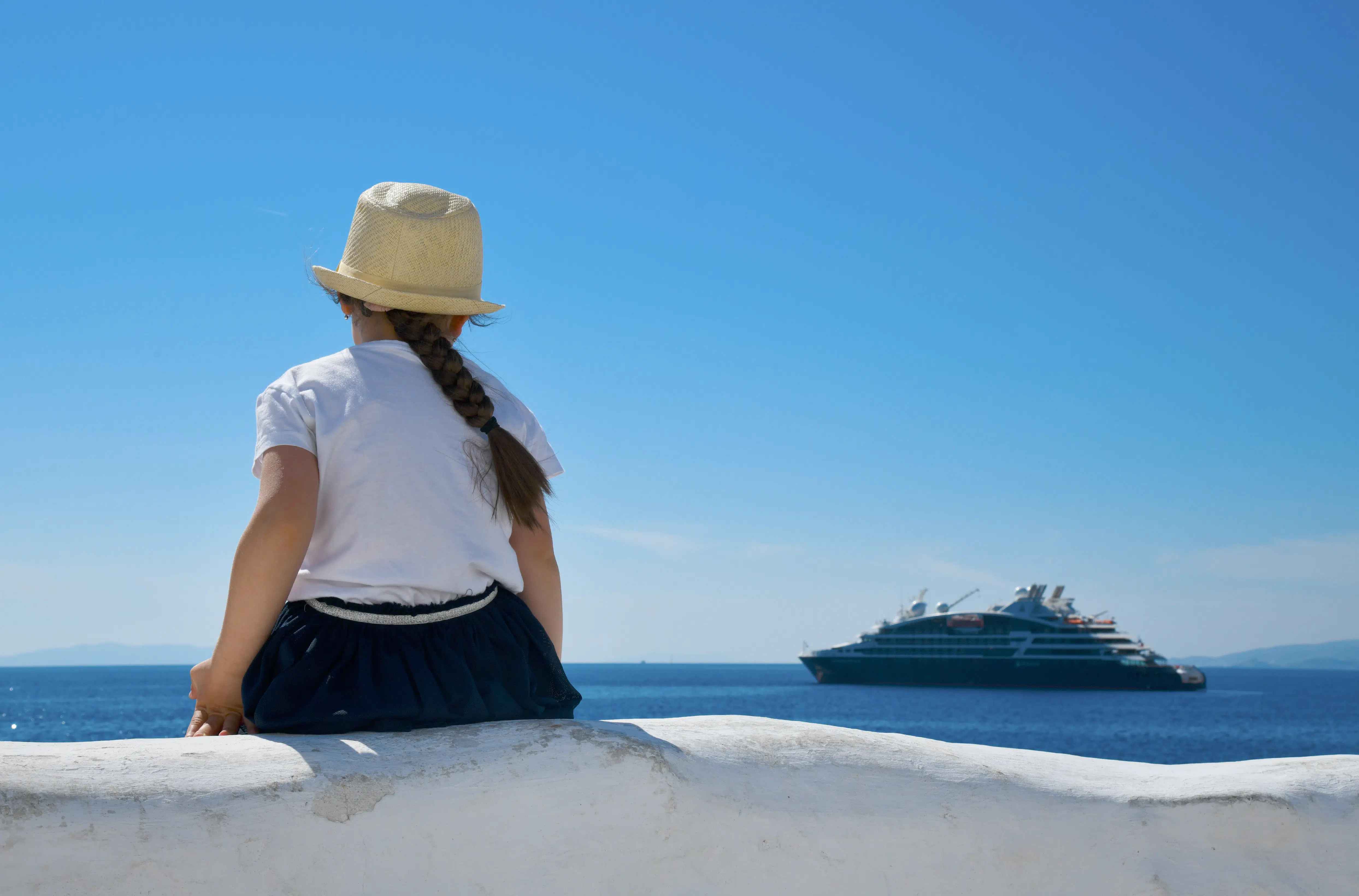
Ocean Young Explorers
Because it’s important to reach new generations and make children aware of environmental protection issues from an early age, PONANT has joined forces with the Maud Fontenoy Foundation to help run its Ocean Explorers club for children. In total this summer, 17 cruises will offer children aged 4 to 13 a programme of activities dedicated to the ocean protection theme.
Raising awareness of oceans protection from an early age
The Maud Fontenoy Foundation is providing PONANT’s activity teams with fun educational kits, activity sheets and videos highlighting why oceans need to be protected. From creative activities (drawing, painting, a giant map of the world to colour in, etc.) to meditation initiation sessions, the programme is very varied. And from 2023, it will also include fun educational workshops on the water cycle, biodiversity, astronomy, and geology.
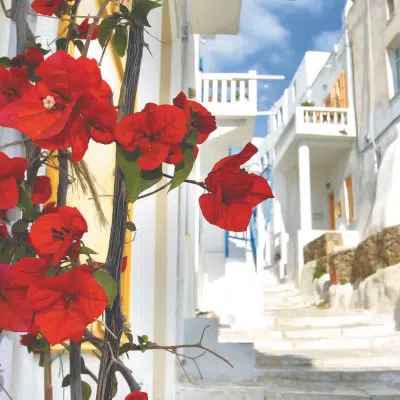
Excursions and Talks
Children aged 4-13 will have the opportunity to do excursions such as watersports, beach games and swimming, treasure hunts, and even guided tours. For larger groups, a naturalist guide will join the team running the sessions and give a talk on local fauna and flora.
Laundry
Your stateroom Officer will be able to take care of your laundry**. The washing and ironing of your clothes will take between 24 and 48 hours. Only ironing** can be delivered on the same day. As dry-cleaning is not possible on the ship, please only give us clothes that can be washed in water.
** These services are not free of charge and are billed directly to your stateroom account.
Smoking Policy
Closed spaces such as the lounges, the dining room, the staterooms and the reception are non-smoking areas. We invite you to smoke in designated outdoor parts of the ship.
Power Adapters
Adapters are provided on board, they are available at the reception office of our ships.
European Standard Sockets
The 220 volt 50 hertz alternating current is distributed by sockets meeting European standards. Onboard power is 200 volt AC (European standard) and 110 volt AC (North American standard). For safety reasons, hair irons and clothes irons cannot be used in staterooms. Please note that on Le Ponant, 110 volt AC is only available in stateroom bathrooms.
Age Restrictions
Children under one year of age shall not be authorised to embark on the ships.
For children aged between 1 and 8 years old, an authorisation to board the ship must be made in writing to PONANT. Subject to agreement, a liability waiver must be completed and returned to the company to validate the registration.
On classic cruises (“yachting”), children are accepted from the age of one, with a maximum of 5 children between 1 and 6 years old on board.
On “expedition” cruises children are accepted from 6 years old (except cruises aboard Le Commandant Charcot) and must be fully independent during all the outside activities organised and during disembarkation in rubber boats, be sufficiently tall to sit on the inflatable sides of the boats, and old enough to understand, and immediately respond to the orders given by the persons in charge. As a result, children’s participation in any activity in an inflatable boat shall be subject to the agreement of the Captain and of the Expedition Head, depending on the sea conditions, and the difficulty of disembarking at each location visited. The ships do not carry Parka’s in children’s sizes. Parents must arrange to bring a suitable Parka for children. In all cases, children and young people under the age of 18 are at all times on board or on land under the full and total responsibility of their parents or carers.
Children aged 4 years or more can be welcomed in the Kid’s Club when the service is offered on board
Languages
The crew are bilingual in French and English. All signage and announcements made are in French and English. On certain cruises, crew members also speak other languages.
Telephone
A satellite telephone system is at your disposal for contacting anyone, anywhere in the world. The cost of the call is added to the stateroom account (€6/minute). Calls that you receive can be transferred directly to your stateroom or to any other communal area on the ship. To receive or send faxes, please see Reception.
Wi-Fi
Free Wi-Fi internet access is available on all of our ships, in both the staterooms and the communal areas. One or several computers are at your disposal in the recreation centres. Please note that the Wi-Fi connection may be discontinued depending on the navigation area and landscapes that may block the vessel from satellite coverage, especially at high latitudes (no connection possible beyond 80° North or South), or for technical reasons beyond our control.
Medical Facilities
There is a doctor on board available to the passengers on all our ships:
- The schedules of consultation are listed each day in the log book (emergency consultation 24/7).
- The Sisterships, PONANT Explorers and Le Commandant Charcot also have a hospital for any small surgery.
- During the excursions, the passengers are accompanied by a doctor or a nurse.
- There is a fee for consultations on board . The price may vary according to the time and place of the consultation (hospital or staterooms). You must also pay for medications.
- The doctor on board is not authorised to distribute sick leaves and prescriptions. Only accounts and invoices are provided which may be used by the passenger to obtain a refund from his/her health insurance if his/her contract allows.
Medical Consultations
There is a charge for medical consultations undertaken by the doctor or nurse on board. The price can vary according to the time and place of the consultation (hospital or stateroom). Any medication must also be paid for by the passenger. If using medications on a regular basis make sure to bring adequate supplies for the duration of your cruise.
Special Medical Treatment
If you have any special treatment, we ask you to inform the reservation service when you register for the cruise, to note it on the information sheet before departure, then inform the on-board crew at the moment of departure and always keep your medication with you for the duration of the cruise.
Seasickness
Our ships (except Le Ponant) have stabilisers equipped with dynamic fins which adapt to the movements of the ship. This system allows the ship to anticipate and compensate for the pitching and tossing of the sea to achieve greater stability. Passengers suffering from seasickness will see their symptoms alleviated and are pleasantly surprised to not feel uncomfortable during their journey. However it is wise to bring travel motion medication with you for peace of mind.
Guests with reduced mobility
Our Sisterships, PONANT EXPLORERS and Le Commandant Charcot were designed for people with reduced mobility in mind:
- Specially designed staterooms;
- Access ramps allowing easy movement in communal areas;
- Posters, signage and stateroom numbers are translated into Braille.
Despite these arrangements, each passenger should be able to be independent or travel with a close family member or friend who can give them whatever assistance they require during their trip.
If a person has not been judged suitably fit for travel in complete safety, the company reserves the right to refuse their embarkation. Disembarkation in difficult places or in a Zodiac® is subject to the approval of the Captain, who will always have the safety and wellbeing of the passenger in mind.
Packing Tips
Technical Accessories
We advise you to equip yourself with a ski mask, sunglasses, walking poles (available to purchase in the shop), a waterproof rucksack, binoculars, a technical watch, a mosquito head net (for the Arctic) and a waterproof pouch.
Dress Code
We advise our passengers to wear casual and elegant outfits at their convenience, and more formal attire for the Captain’s Dinner.
Sustainable Development
Sustainable development is enshrined in the company’s articles of association and has been at the heart of the PONANT project since its inception. Founded over thirty years ago by committed sailors, the company was born out of a desire to share a passion for the oceans and the treasures of the Earth. This responsibility commits us to a respectful dialogue with the environment and the populations we meet and to investing in many fields related to the preservation and development of the natural and cultural heritage of the polar and oceanic regions.
Clean Ships
We were among the first cruise operators in the world to abandon the use of heavy fuels, and our ships are equipped with electric diesel engines and SCR catalytic converters, which enable a reduction in fuel consumption and emissions. Our polar exploration ship, Le Commandant Charcot, is a hybrid-electric vessel, propelled by liquefied natural gas (LNG). LNG enables a 25% reduction in carbon emissions, an 85% reduction in nitrogen oxide emissions and a 95% reduction in fine particle emissions. Each time we design a new ship, we equip it with the latest available eco-technologies, enabling us to maintain our position as the cruise industry’s environmental leader, ahead of international regulations in some areas. A commitment recognised by many independent organisations:
- Our entire fleet is Clean Ship certified by the Bureau Veritas. This certification guarantees that our ships fulfil very precise criteria: emissions levels, waste processing, waste water etc.
- In 2020, PONANT was recognised as “the cruise operator with the greenest fleet in the world in terms of airborne emissions” by the German NGO, NABU.
- PONANT was awarded the Prix des Palmes du Tourisme Durable 2020 (Prize for Sustainable Tourism) in the “Voyage” category for the elimination of heavy fuel oil in favour of LS MGO.
- In 2019, PONANT became the first European cruise company to obtain the North American Green Alliance certificate. This certifies that its members have adopted practices and technologies that are respectful towards the environment.
- PONANT is also a signatory of the Charte Bleue from Armateurs de France, which commits the maritime sector to act to protect the marine environment.
Wastewater
All of the wastewater is treated by means of processes that exclude the use of chemical products. The recycled water is used to clean the exterior of the ship. The water that is discharged into the sea is treated, drinkable water.
Waste
We have optimised our organisation in order to reduce waste at the source. Waste is nonetheless still produced on board. As of 2020, 60% of this is sorted and recycled, with an objective of 85% set for 2023. We ensure the complete traceability of this waste.
Single-use plastics
We have eliminated the use of single-use plastics (straws, cups, food serving trays, laundry bags etc.). A metallic flask is issued to each passenger on expedition cruises and water fountains are available in the common areas of the ships. We are also developing the bottling of our water in glass bottles.
Special Diets
And so that everyone’s tastes are catered to, special menus are available on request for guests with specific dietary requirements (low-fat, vegetarian, gluten-free, etc).

Deck 7
- Spa
- Fitness Centre
- Hair Salon

Deck 6
- Panoramic Lounge
- Art Gallery/Photo Video
- Privilege Suites
- Grand Deluxe Suites
- Deluxe Suites
- Prestige Suites
- Prestige Staterooms

Deck 5
- Bridge
-
Owners Suite
- Prestige Suites
- Deluxe Suites
- Privilege Suites
- Prestige Staterooms

Deck 4
- Restaurant
- Deluxe Suites
- Prestige Staterooms
- Accessible Staterooms

Deck 3
- Theatre
- Medical Centre
- Excursion Desk
- Reception Desk
- Shop
- Main Lounge
- Grill
- Pool
- Deluxe Suites
- Deluxe Staterooms
